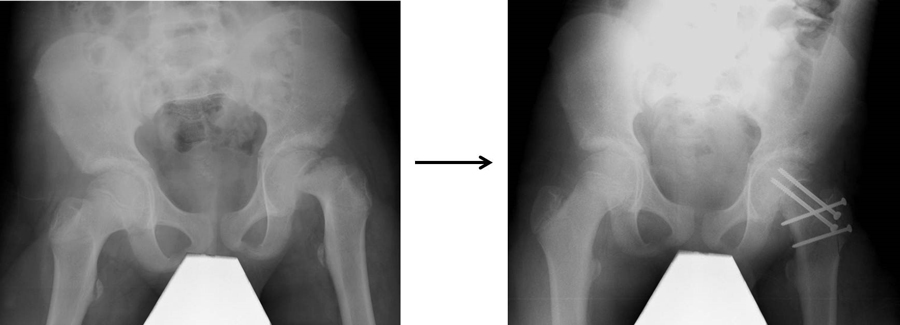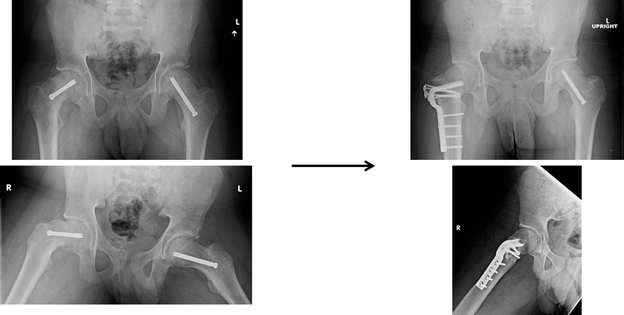Slipped Capital Femoral Epiphysis (SCFE) Treatment
When a SCFE has been diagnosed, the child will be admitted to the hospital and placed on bed rest until surgery. There are two methods for treating SCFE:
- In situ pinning – The aim of this surgery is to secure the hip in its current position and prevent further slipping. One or two screws are placed through the skin through a small incision into the femoral head to secure the epiphysis to the femur.

- Open surgery – This surgical procedure is used for patients with unstable SCFE to align the epiphysis on the femur and attempt to prevent the loss of blood flow to the femoral head. Additionally, it is used in some cases of stable SCFE when the deformity to the top of the femur is significant enough to cause long-term pain, limited function and early arthritis.

What are the outcomes for SCFE?
The goals of SCFE surgery are stopping the progression of the slip, improving pain and function, and limiting long-term consequences associated with avascular necrosis and early arthritis. Children are usually on crutches for six weeks after in situ pinning and 12 weeks after open surgery.
The expected short-term outcome after SCFE surgery is a return to full activity without pain. The amount of slipping of the epiphysis, or the degree of deformity to the femoral head, affects the amount of limitation in range of motion and activity.
The long-term outcome after SCFE surgery is related to the amount of femoral head deformity – the greater the amount of slipping, the higher likelihood for developing arthritis in adulthood. Children that develop avascular necrosis of the hip after an unstable SCFE do poorly, experiencing pain and the possibility of early arthritis.
Is is possible for SCFE to happen to the other hip?
Yes, it is possible for SCFE to happen to the other hip. The risk for it occurring depends on many variables, but it is important that if pain begins to happen in the other hip that the patient seeks immediate medical attention. In some cases, the risk for certain children is high enough to warrant in situ pinning the good hip to prevent a slip from occurring.
What is FAI and how does it relate to SCFE?
FAI stands for femoroacetabular impingement and refers to a mismatch between a deformed femoral head from SCFE and the acetabulum. The slipped epiphysis leads to the ball not moving in a normal fashion and causing the femur to impinge on the acetabulum during normal motion. This can cause pain and limitation in function for active teenagers who had a SCFE. There are certain treatments available to these patients that include surgical options to correct the impingement, repair damaged structures within the joint, and improve pain and range of motion of the hip. It is unclear at this time whether these surgeries delay or prevent the onset of arthritis in a patient with a SCFE.

